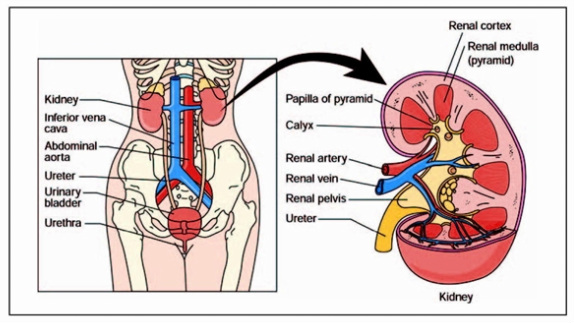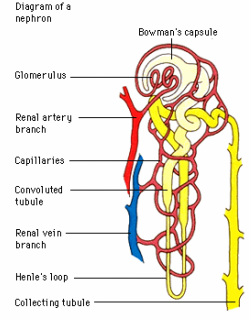The Urinary System

The urinary system is the main excretory system in humans. The urinary system is made up of two kidneys, which are located just in front of the lower ribcage, the ureters, which transport urine, made by the kidneys, to the bladder (a hollow muscular organ), which stores urine until it is excreted. Then the sphincter allows urine to flow and keeps the urethra tightly shut. Finally there is the urethra, which is the passage way for urine to get out of the body. The act of urination is when the bladder contracts, the sphincter relaxes, and urine is forced through the urethra.
The Kidneys
Located in the back of the abdominal cavity are the kidneys, which are part of the urinary system. The kidneys filter about 162 quarts of blood each day. The kidneys form urine and remove urea, toxins, medications, and excess ions. They also balance water, salt, acid, and base levels. The kidneys also send vital substances back to the blood. About 1.3 quarts of the total processed liquid leaves the body as urine. Tubes, at the hilus, remove urine from the kidneys. The hilus allows blood vessels, lymph vessels, and nerves to enter and exit the kidneys. The hilus leads into a space called the renal sinus. The kidneys have 2 layers, the renal cortex and the renal medulla. The renal cortex is the outer reddish layer, and the renal medulla is a reddish brown layer.
The Nephrons

Diagram of a Nephron
The nephrons are made of cup-shaped capsules containing capillaries and the glomerulus, and a long renal tube. The renal artery transports blood to the kidneys, and branches into capillaries associated with the glomerulus. Water and solutes from the blood filter into the capsules because of arterial pressure. The proximal tubule, which includes the loop of Henle, allows fluid to flow, and then into the distal tubule. The distal tubule empties into a collecting duct. Fluids and solutes are returned to the capillaries that surround the nephron tubule.
The Adrenal Gland & Aldosterone
The adrenal glands, which sit atop both kidneys, secrete aldosterone. When the blood has little salt, the adrenal glands send aldosterone, which tells the nephorns to hold more salt, letting little salt to get into the urine.
ADH
The hypothalamus gland in the brain, releases ADH. When the blood gets too concentrated, ADH is sectreted. The ADH tells the nephron cells to retain more fluid in the body, therefore producing less urine.
The Renal Tubule
There are over 1 million nephrons in each kidney. A nephron has a tuft of capillaries surronded by a capsule on top of a curving tube. A glomerulus is a tuft of capillaries. The cup-shaped capsule is called Bowman's capsule. The glomerulus and Bowman's capsule form the renal tubule. The renal tubule is surronded by blood vessels, and urine forms in it. The renal tubule joins with collecting tubules, which merge into bigger tubes, which empty urine into the ureters, located in the renal sinus. The hilus allows the ureters to exit the kidney.
Kidney Problems
Urinary tract infections, such as cystitis (a disease where bacteria inflames the bladder), are disorders in the urinary tract. Kidney stones, solidified salt,)can obstruct the urinary passages, and can cause pain and bleeding if it gets into the urethra. Physicians may use shockwaves to disintegrate the kidney stone, or use surgery to remove the kidney stone if it does not pass naturally.
When the kidneys lose the ability to function properly, renal failure may be occuring. When nitrogenous wastes build up in the blood, pH levels drop, and urine production slows down. If renal failure is not treated, it may result in death. Chronic renal failure causes the urinary system to decline, and permanently shuts down kidney functions.
Two methods of helping chronic renal failure are hemodialysis and kidney transplant. in 1945, William J. Kolff of Holland built the first Hemodialysis machine. Hemodialysis is when an artificial kindney machine cleans the blood of wastes and adjusts the composition of ions. The machine takes blood from the radial artery, located in the arm. The blood passes through the dialysis tubing, which is immersed in a sloution. The solution cleans the wastes of the blood, and then returns the clean blood back into the body. Kidney transplants involve a surgeon replacing a diseased kidney with a good kidney that was donated by a donor with a matching kidney. 23,000 people in the U.S wait for donors each year, but fewer than 8,000 get them. Current researchers and urologists hope to develop a new drug that makes dialysis membranes better for the artificial kidney machine, and therefore helping to beat kidney failure.
When the kidneys lose the ability to function properly, renal failure may be occuring. When nitrogenous wastes build up in the blood, pH levels drop, and urine production slows down. If renal failure is not treated, it may result in death. Chronic renal failure causes the urinary system to decline, and permanently shuts down kidney functions.
Two methods of helping chronic renal failure are hemodialysis and kidney transplant. in 1945, William J. Kolff of Holland built the first Hemodialysis machine. Hemodialysis is when an artificial kindney machine cleans the blood of wastes and adjusts the composition of ions. The machine takes blood from the radial artery, located in the arm. The blood passes through the dialysis tubing, which is immersed in a sloution. The solution cleans the wastes of the blood, and then returns the clean blood back into the body. Kidney transplants involve a surgeon replacing a diseased kidney with a good kidney that was donated by a donor with a matching kidney. 23,000 people in the U.S wait for donors each year, but fewer than 8,000 get them. Current researchers and urologists hope to develop a new drug that makes dialysis membranes better for the artificial kidney machine, and therefore helping to beat kidney failure.
The Stages of Cleaning the Blood
Stage 1-
Filtration is stage 1 in cleaning your blood. Filtration, when liquid passes through a filter, occurs in the glomeruli. Plasma, the liquid portion of the blood, is forced through the capillary walls by blood pressure. Plasma contains water, glucose, amino acids, and urea. Some things, like blood cells and proteins, can't pass through the wall because they are too big. This new fluid, called filtrate, enters the renal tubule after it collects in the capsules.
Stage 2-
Stage 2 is reabsorption, when the filtrate sends needed substances to the bloodstream. Reabsorption occurs in the renal tubules, which pass glucose and other nutrients, water, and essential ions materials to the surrounding capillaries. 100 percent of glucose is usually reabsorbed, but if glucose is found in the urine, it is a sign of diabetes mellitus. Diffusion and active transport are both involved in reabsorption, which uses energy as adenosine triphosphate. Urine forms from the left-over waste-containing fluids.
Stage 3-
The third stage is when tubular secretion allows certain substances to exit the capillaries and enter the renal tubule. Tubular secretion is getting wastes, like penicillin and phenobarbital, into the urine. Urea, uric acids, and excess potassium ions are also secreted. The pH of the blood is maintained by tubular secretions.
Filtration is stage 1 in cleaning your blood. Filtration, when liquid passes through a filter, occurs in the glomeruli. Plasma, the liquid portion of the blood, is forced through the capillary walls by blood pressure. Plasma contains water, glucose, amino acids, and urea. Some things, like blood cells and proteins, can't pass through the wall because they are too big. This new fluid, called filtrate, enters the renal tubule after it collects in the capsules.
Stage 2-
Stage 2 is reabsorption, when the filtrate sends needed substances to the bloodstream. Reabsorption occurs in the renal tubules, which pass glucose and other nutrients, water, and essential ions materials to the surrounding capillaries. 100 percent of glucose is usually reabsorbed, but if glucose is found in the urine, it is a sign of diabetes mellitus. Diffusion and active transport are both involved in reabsorption, which uses energy as adenosine triphosphate. Urine forms from the left-over waste-containing fluids.
Stage 3-
The third stage is when tubular secretion allows certain substances to exit the capillaries and enter the renal tubule. Tubular secretion is getting wastes, like penicillin and phenobarbital, into the urine. Urea, uric acids, and excess potassium ions are also secreted. The pH of the blood is maintained by tubular secretions.
